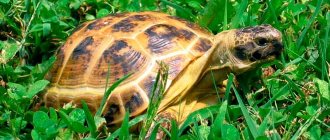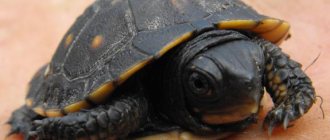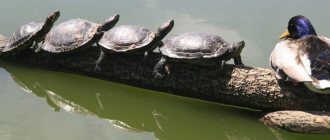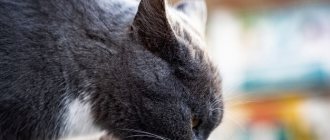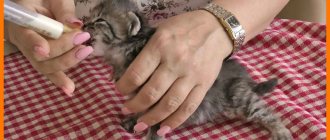Turtles
Turtles are now very common pets. They are interesting to watch, they are smart, remember their owner and live long enough. To prevent the land turtle from getting sick and causing problems, you need to make sure that it receives everything it needs - care and nutrition.
In the wild, turtles get their own food - they choose grass and algae, find berries and roots. At home, it is the owner’s task to provide the turtle with all the necessary vitamins and substances.
You need to take nutrition seriously - a pet that eats from a human table will not live long and will get a bunch of diseases and stomach problems.
Keeping a land turtle at home
A turtle at home requires placement in an aquarium, terrarium or enclosure. There are many reasons for this. Crawling freely around the apartment, your pet may encounter such dangers as:
- dust that exists in every apartment - it can settle and accumulate on a turtle’s shell;
- bacteria that can cause various diseases;
- drafts;
- unsuitable temperature and humidity of the room where the animal crawls;
- lack of ultraviolet radiation, due to which the turtle may lack some vitamins that the body produces when exposed to sunlight;
- other domestic animals, for example, cats or dogs, and even the person himself can injure the land creature.
Do I need to give water to a tortoise?
In addition to the question of the nutrition of land turtles, pet owners are wondering whether land turtles need to be watered and how they drink. Despite long-term observations of turtles, an exact answer has not yet been given - how turtles drink and whether they need water. Some turtles are able to do without water, while others quench their thirst from reservoirs.
We invite you to familiarize yourself with Microlax for cats: instructions for use
Due to the structure of the turtle's head, it experiences discomfort when trying to drink water - liquid flows out of the nostrils or flows down the animal's neck. For this reason, many experts agree that turtles do not need an additional source of liquid, receiving the necessary moisture from food or during water procedures.
At home, a land turtle will drink water from a drinking bowl if it becomes dehydrated - in this situation, it will try with all its might to replenish the lack of fluid in the body. But it is better not to bring the animal to such a situation, but to provide succulent food in a timely manner and carry out regular bathing (we will talk in more detail about food and bathing below).
As mentioned above, land turtles take the bulk of their liquid from food, so you should include in the animal’s diet more juicy fruits, vegetables, greens (cucumber, lettuce, cabbage...), which can not only saturate the turtle, but also replenish the moisture necessary for life. .
Also, to replenish the turtle's fluids, you can place it in a container with water (a small amount), so it can replenish the necessary moisture through the skin.
Caring for a land turtle
Any land turtle needs proper care, which includes maintaining the cleanliness of its home, itself, and ensuring a proper lifestyle. So, how to care for a land turtle:
- feed regularly and variedly in accordance with one or another habitual diet;
- bathe in warm water every week - this gives land turtles great pleasure, in addition, it helps to increase appetite and good intestinal function;
- take care of the claws - in captivity they do not have time to grind down as they grow, so they need to be trimmed periodically with a special nail clipper;
- take it out for walks in the fresh air - on warm and sunny days it is very useful to give the turtle the opportunity to walk in the open air, but you need to constantly monitor it, since it can disappear from sight in the depths of the grasses in a very short time.
What to feed a land turtle?
A natural question for novice tortoise lovers is: what to feed a land tortoise at home? Their main diet consists of plant foods - berries, fruits, vegetables, grass. It is best to feed them a mixture of different ingredients - this way their diet will be varied and balanced. You can put food on a flat saucer, the main thing is that it is convenient for the turtle to eat from it. The vegetable and fruit menu in the summer can and should be diversified with clover, dandelions, sorrel, sprouted oats, and pea leaves.
Vitamins for land turtles
Vitamin and mineral supplements are desirable in the diet of land turtles kept at home. Carbonate, bone meal, ground eggshells, and glycerophosphate can be used as mineral additives. They should be given at the rate of 100 mg per 1 kg of animal weight. As for vitamins, the Central Asian domestic land turtle needs natural sources of vitamins A, B12 and D3. You should not give her oil preparations and vitamin D2. She must get everything she needs from food.
Turtle nutrition in winter and summer
Despite the fact that the animal is in captivity, it can sense the approaching cold weather, which contributes to a change in taste preferences. In the summer, the turtle eats more juicy foods, but with the arrival of a colder season, it prefers soaked hay and less juicy vegetables. In any case, you need to monitor the behavior of the turtle, as well as what it consumes more from food.
What to feed a land turtle?
These animals are among the most unpretentious. Turtles eat little and do not require special care - they are not difficult to keep at home. All land turtles are herbivorous reptiles. As mentioned above, their diet consists of 95% plant foods and 5% animal foods. Feeding food that is inappropriate for this group, such as meat, is fraught with diseases.
What does the turtle like?
Turtles' favorite foods are lettuce and dandelion leaves - they can even be dried for the winter. She is also partial to vegetables and fruits. The main food consists of almost all plants, vegetables, fruits, and berries that are non-poisonous to turtles. You can feed field grasses and houseplants, such as: aloe, pea stems and leaves, tradescantia, alfalfa, timothy, lawn grass, plantain, gooseberry, rhubarb, sprouted oats, barley, thistle, sorrel, coltsfoot.
The vegetable menu consists of peppers, beans, pumpkin, carrots, zucchini, radishes, beets, artichokes, this list will be supplemented by cucumber and horseradish, which should not be given in large quantities.
It is allowed to feed land turtles with a variety of fruits and berries: apples, apricots, plums, peaches, mangoes, bananas, oranges, tangerines, watermelon, raspberries, strawberries, blueberries, wild strawberries, blackberries, blueberries. Additional complementary foods include: mushrooms, dry commercial feed, dry sea cabbage, young sunflower seeds, soybean meal, bran.
Shouldn't be given to turtles
It is undesirable to feed onions, garlic, spinach, spicy herbs, grasshoppers, crickets, domestic cockroaches, poisonous insects, cherries, eggshells (causes salmonellosis), or feed one type of vegetable or fruit.
Prohibited foods include:
- potato,
- medicinal products containing alkaloids,
- indoor (dieffenbachia, euphorbia, azalea, elodea, ambulia, oleander, elodea.
- vitamin D2 and the drug gamavit (they are toxic to reptiles).
- milk, bread, citrus peels, seeds from fruits and berries, pet food, “human” food, including cereals (with the exception of rolled oats, which are not boiled, but soaked in water or vegetable juice, it should be given no more than once a day). month), meat, any prepared foods.
Poor nutrition causes irreversible changes in the animal’s liver, which can cause its life to be much shorter.
Feeding features of the species
All natural species of turtles are divided according to their feeding method into three large orders:
- predatory;
- herbivores;
- omnivores.
Each of them has their own list of food products necessary for a full-fledged existence. But among the land species of turtles there are no predators, so it is important to consider only the diet of herbivores and omnivores. When purchasing these pets, it is imperative to find out what type of food they belong to.
The omnivorous species that are suitable for keeping at home and most often found in the world are the Mediterranean, musk, flat and Balkan.
Mediterranean
musky
Balkan
Flat
Herbivores include star, Indian, Central Asian, Egyptian, serrated, red-headed, radiated, Galapagos.
Indian
Star-shaped
Galapagos
Radiant
Redhead
Serrated
Egyptian
Central Asian
Omnivores
Their diet must necessarily consist of live food, for example:
- mice and small rats;
- frog;
- snails;
- insects - tubifex, bloodworms, daphnia, beetles, caterpillars, worms;
- slugs;
- fish and seafood.
The plant part of the diet should contain:
- vegetables;
- fruits;
- berries;
- aquatic plants;
- various herbs.
Herbivores
80% of the diet of these land turtles should be products of plant origin - various salads and spinach (leafy part), dandelion, cabbage.
Additional food:
- vegetable crops - pieces of carrots, cucumbers, zucchini, tomatoes, sweet peppers;
- fruits - apples, pears, peaches, apricots, bananas, citrus fruits;
- berries - cherries, raspberries, strawberries, grapes, currants, watermelon;
- other herbs - coltsfoot, sorrel, plantain, alfalfa, legumes;
- mushroom crops, such as champignons;
- special prepared food;
- bran and flakes from plant crops, sunflower seeds.
We recommend reading the article on what to feed pet turtles.
List of prohibited products
If you feed your turtle incorrectly, irreversible pathological processes in the liver may occur. The introduction of prohibited foods to the menu can cause the death of your pet.
Their list is very extensive. It is prohibited to give to reptiles:
- spicy herbs;
- herbs rich in alkaloids;
- onion and garlic;
- potato;
- zest;
- milk;
- cat and dog food;
- eggshells, as they can be contaminated with bacteria of the genus Salmonella;
- poisonous indoor plants (water plague, oleander, limnophila, azalea, spurge, dieffenbachia);
- domestic cockroaches, crickets and grasshoppers;
- vitamin D2, since it is poisonous;
- dishes from the owners' table: sausages, sausages, cheese, porridge (you can give rolled oats, which need to be steamed and not boiled), canned food, fried and boiled food.
Mr. Tail explains: foods prohibited for land turtles
The owner of these reptiles should be well aware of the foods that should never be given to pets:
- stone fruit seeds - apricots, peaches;
- citrus peel;
- plants that are poisonous and medicinal, such as buttercup, nightshade, potato and tomato tops, crocus, narcissus, milkweed, delphinium, hydrangea, mistletoe, dieffenbachia, azaleas, lilies, elodea;
- sausages and canned goods.
Porridge, baked goods, dairy products, eggs and eggshells, meat, onions, garlic, celery, spinach stems, radishes, and spicy herbs are allowed only in minimal quantities.
The turtle needs love too
It is very important to understand that a turtle is a living creature that requires care and attention, and not a toy that can be played with and left to the mercy of fate. If you have chosen these unique reptiles, take a responsible approach to the question of what to feed your turtle at home.
After all, the health and life of your pet depends on it. The more seriously you take the conditions of its existence, the longer the turtle will be able to please you. When buying a turtle, contact experienced sellers who can tell you what to feed a water turtle at home and what to feed a land turtle, so that later you don’t have to guess why your pet died, because you fed it.
It turns out that if a turtle is not fed correctly, it begins to be capricious, eat poorly, or even refuse food altogether. or steppe turtles are no exception. In order for your pet to feel at ease, properly structure your baby’s diet.
What to feed the Central Asian land turtle?
Let's start with the fact that absolutely all turtles love plant foods. Healthy plants include cabbage, pumpkin, watermelon, melon, lettuce, apples and dandelions. They will not refuse berries - raspberries, cherries and strawberries. Milk with white bread soaked in it will also appeal to the armored animal.
What else is possible? Calcium is necessary for building and maintaining the strength of the bone cover - the shell. Therefore, fresh cottage cheese must be present on the menu. Semolina and buckwheat porridge will usefully enrich the list of food products.
Don't think that turtles are vegetarians. They eat absolutely everything. Therefore, you need to be very careful when decorating terrariums. After all, almost everything that gets there will be “tested.” So, do not deprive your pet of protein food. One tablespoon of raw minced meat or half a hard-boiled egg is enough. But instead of feeding a domestic land turtle with meat that is harmful to it, make up for the lack of protein by replacing the product that is bad for the kidneys with a real worm, which is fed to aquarium fish. But don't overdo it. Any food of animal origin can lead to indigestion. It’s better to replenish your turtle’s kitchen with beans rich in vegetable protein.
Do not overfill your turtle's diet with tomatoes, cucumbers and carrots. They don't like them. This is easily explained, because in the wild these animals eat berries, desert plants or carrion.
What to feed a land turtle in winter?
Turtles usually hibernate during the winter. But the house is quite warm during this cold period. Therefore, the turtle does not sleep, but simply becomes slow. What should you feed your land turtle at home during this period?
Food products can be left the same. But don't be surprised if your little friend can't make it through the summer daily quota. An approximate daily diet can be calculated for the winter period, and it will look something like this:
- carrots – 30 grams,
- boiled potatoes – 20 grams,
- cabbage – 30 grams,
- white bread – 20 grams,
- fish oil – 0.5 grams,
- beets – 20 grams.
Just don’t forget to enrich this list with herbs in the summer, for example, dandelion, the leaves of which can be picked far from a busy and polluted highway and city.
Does a land turtle need to be given water?
We told you what to feed domestic land turtles. But, after all, they also need water, although they drink quite rarely: some drink it once every one to two weeks, while for others, one “date” with water per month is enough. The frequency with which water treatments need to be administered depends on what the animal eats over a certain period of time. If it is cabbage, then the cells of the turtle’s body receive a sufficient amount of moisture, and you will have to “bathe” less often. But if the majority of the daily diet consists of white bread, baths should be arranged a little more often.
Although, in order not to rack your brains, give your turtle a bath day once a week or a week and a half. Pour a little less than a centimeter of water into the basin. The pet's nose must be above the water level so that the land inhabitant of our planet does not suffocate. Place the animal in the water and leave it to enjoy for half an hour. Believe me, this time is enough for the baby to have time to get drunk and take a swim.
Unfortunately, many people do not take turtles seriously enough, not like other pets, they know little about the peculiarities of keeping and caring for them, and most importantly, they have little interest in the question of what to feed turtles. But these babies also require a balanced diet, various nutritional supplements for active growth and well-being.
Sample menu and additional components
The menu for your pet should be prepared in advance so that you don’t have to worry about the lack of certain foods in the diet.
Sample menu:
- 50 g of green stems are given every two to three days.
- Beet pieces should be given. No more than 30 g per day.
- 30 g of cabbage leaves once every 1–2 days.
- Boiled potatoes in the amount of 30 g per day.
- Proteins enter the turtle's body through the consumption of bloodworms, worms, and lean meat pieces. There should be no more than 5 g per day.
- White bread – 20 g per day.
- Vitamin supplements, such as fish oil. There should be no more than 1 g per day.
- Porridge – semolina, buckwheat, cottage cheese. Do not give more than once a week.
Three groups of turtles
Based on their feeding type, turtles are divided into three groups: carnivores, omnivores and herbivores.
. Each of them corresponds to a certain ratio of animal and plant foods. Feeding inappropriate food for each group of turtles is fraught with diseases of the internal organs, digestive complications, and metabolic problems. You also need to include calcium and vitamins in your diet weekly. What food should be given to each group?
Predatory
The food of predatory turtles should consist of 80% animal food and 20% plant food. This group includes almost all aquatic species and all young aquatic ones, such as young red-eared, caiman, trionics, swamp, musky, etc.
The main food for them is:
- lean fish, live or thawed, with entrails and small bones. For young turtles, the fish should be finely chopped (spine, excluding ribs) with bones, for adults - whole or large pieces. Large bones can be ground or finely chopped.
- beef or chicken liver is given once a week;
- seafood such as green (not pink) shrimp, sea cocktail;
- mammals (small): naked mice, rat pups, runners.
The turtle can eat all seafood, as well as fish, only raw; heat-treated food should not be given;
Additional food
, which should be given once a week, serves:
- Dry food for freshwater turtles, for example, in the form of sticks, tablets, flakes, granules, capsules, Sulfur, etc.
- Insects: moth, food cockroaches, grasshoppers, bloodworms, crickets, earthworms, gammarus and so on;
- Mollusks, amphibians, invertebrates: slugs, frogs, small snails with shells, tadpoles and similar swamps.
It is prohibited to give to predatory turtles:
meat (beef, chicken, pork, lamb, sausages, sausage, any type of minced meat, etc.), as well as fatty fish, milk, cheese, bread, fruit, dog or cat food, etc.
The diet of this group of turtles should consist of 50 percent animal food
and 50 – vegetable. Omnivorous turtles include semi-aquatic and adult aquatic turtles, some types of land turtles: spiny turtles, coora turtles, adult red-eared turtles, Spengler's turtles, red-footed turtles (coal turtles), etc.
Their menu consists of half animal food, see the list above, and half plant food, the list is below. Aquatic turtles are pampered with fish
and seafood (as animal food), and mice are given to land animals.
- Plant food for aquatic species are plants growing in water conditions,
- Land animals are given plants that live on the ground, and fruits and vegetables are added to them.
Herbivores
The menu of this group of turtles is based on plant foods, which make up 95% of the total diet, animal food consists of 5%.
Herbivores include: all land turtles, including radiated, flat, Central Asian, Greek, spider and others.
The main food of this group is:
- greens, it makes up 80% of the entire menu (semi-dry or fresh salads, edible leaves, flowers, succulents, herbs.
- vegetables - 15% of the diet (pumpkin, cucumbers, zucchini, carrots...)
- fruits that are not very sweet (apples, pears, etc.) are represented in 5% of the menu.
Additional food
once a week, it includes:
- non-poisonous mushrooms, such as russula, boletus, champignons, etc.
- dry balanced food for land turtles of the brands “Sera”, “Tetra”, “Zumed”.
- other: soybean meal, dry yeast, raw young sunflower seeds, bran, dried seaweed...
It is prohibited to give meat; this category includes: any minced meat, sausages, sausage, chicken, beef, pork, etc.). Also fish, milk, cheese, cat or dog food, bread...
Feeding rules
It is advisable to eat at the same time every day, preferably in the morning.
When feeding turtles, you must follow simple rules:
- Up to a year of age they are fed every day, after two years they can be fed every other day.
- Food utensils should always be washed clean before each feeding.
- Portions should be made small, and excess should be removed from the terrarium so that it does not spoil.
- Try to ensure complete rest for your pet while feeding. The turtle is frightened by loud sounds and sudden movements.
- Reptiles should not be taught to eat from their hands. They very quickly get used to this method of feeding, and then refuse to eat from the bowl.
- You should not overfeed your pets, that is, give food too often, this can lead to obesity and distortion of the carapace and plastron.
- Feeding too infrequently is also unacceptable, as this can cause exhaustion and death.
It is necessary to give foods containing calcium a couple of times a week. For example, cottage cheese mixtures, cereal porridges - buckwheat, milk semolina or oatmeal.
Here is a sample list of what to feed your turtle:
apricot (can and should be given) pineapples (it is harmful to give too much) oranges without seeds and peel (it is harmful to give too much) watermelon without seeds and peel (can and should be given)
eggplant (you can and should give it) bananas with peel (it’s harmful to give too much) basil (it’s harmful to give too much)
seedless grapes (you can and should give them) cherries (it’s harmful to give too much)
peas (harmful to give a lot) mustard (harmful to give a lot) grapefruit without seeds and peel (harmful to give a lot) mushrooms (harmful to give a lot) pear (harmful to give a lot)
melon without seeds and peel (can and should be given)
cereal grains (it is harmful to give too much)
zucchini (can and should be given) potatoes (cannot be given) cabbage (it is harmful to give too much) any porridge or cereal (cannot be given) kiwi (can and should be given) dry, canned food (cannot be given) Some types of turtles can be given dry food for land turtles . dry cereal, boiled, filled with water (cannot be given) corn (cannot be given)
onions (feathers) (it is harmful to give too much) tangerines without seeds and peel (it is harmful to give too much) milk (not to be given) carrots along with herbs (can and should be given)
nectarine (can and should be given)
vegetable mixtures (can and should be given) defrost and give cucumbers (it’s harmful to give too much) nuts (cannot be given)
pitted and peeled pamelo (it’s harmful to give too much) not hot pepper (you can and should give) peach (you can and should give) parsley (you can and should give) tomatoes (it’s harmful to give too much) bean sprouts (it’s harmful to give too much)
rhubarb (harmful to give too much) radish (harmful to give too much) radish (harmful to give too much) fish (cannot be given)
salad (can and should be given) lettuce (harmful to give a lot) celery (harmful to give a lot) seeds (harmful to give a lot) pumpkin, sunflower, preferably finely chopped or grated beets (harmful to give a lot) plums (can and should be given) asparagus (it is harmful to give too much) cheese (not to be given)
How and what to feed a turtle: general features
Rational and balanced nutrition
Like the diet of other pets, the diet of any type of turtle should be rational and balanced. A harmonious menu of different types of products, including both plant and animal foods, is necessary for turtles of all types
It is also important to ensure that these animals always have access to a shallow bowl of water, which needs to be changed daily.
Regularity of nutrition
It is important to maintain regular nutrition. An adult turtle of medium size should eat at least half a head of lettuce or at least another amount of other food every day.
If your turtle eats almost nothing, you should definitely pay attention to this: it is likely that your pet is sick. It is advisable to get a scale and periodically weigh the animal, noting fluctuations in its weight, in order to promptly notice the occurrence of problems with your pet’s health.
The importance of calcium in food
It is especially important for turtles to have calcium in their food, which ensures their shell and bone strength. Since there is almost no this important element in plants, it is worth purchasing vitamin supplements containing calcium and adding them to the turtle’s food
It is important to follow the dosage of such supplements, since excessive use will have adverse effects on the animal.
Feeding turtles at home
When wondering what to feed a turtle at home, you should first of all focus on the type of animal, depending on which the choice of rational nutrition is made.
Choosing food that is inappropriate for a particular type of turtle can lead to metabolic disorders in the animal and problems with digestion.
How to organize feeding a turtle
You can feed your turtle in different ways:
- placing food in the water of the aquarium;
- from tweezers;
- leaving food on the sushi island in the aquarium;
- outside the aquarium if you do not want to pollute the water with food debris.
It’s worth hand-feeding the turtle at first so that the animal gradually gets used to being independent and comes to you to eat on its own. It is worth accustoming to new foods gradually, and if there are several turtles, it is worth making sure that all animals get food. Turtles do not eat cold food, so food must be taken out of the refrigerator in advance and given to the animal to eat only when it reaches room temperature. It is advisable to feed the turtle during the day, when the animal is most active, or, alternatively, a couple of hours before bedtime.
Adult red-eared turtles should be fed once every few days, young ones - every day. A land turtle should be fed once every 2 days for an adult and once a day for young animals. Dry food should be consumed only as a supplement to the main food. Young individuals and females in anticipation of offspring must eat every day, and their menu must certainly include calcium and vitamin D in significant amounts in such cases.
Land turtles are the most popular species of reptile. Pets are unpretentious in keeping. Under natural conditions, turtles independently obtain their own food - food of animal and plant origin. But when buying a home, the owner of the animal takes on the responsibility of what to feed land turtles at home.
The diet of land turtles must be varied and contain all the substances and trace elements necessary for the reptile’s body.
The most popular types of land reptiles kept in people's homes among owners are:
- Central Asian (steppe).
- Mediterranean (Greek).
- Egyptian.
- Balkan.
- Musky.
- Leopard (panther).
- Elephant (Galapagos).
- Star (Indian).
- Serrated (yellow-legged).
- Red-headed flathead turtle.
- Radiant turtle.
How to feed
In the process of feeding a land reptile there are certain rules.
- You should not feed your pet frequently. Young animals are fed during the day once a day. Feeding in the evening is allowed, but must be done 3-4 hours before the animal goes to bed. Pets older than 2-3 years are transferred to less frequent meals - once every two days.
- Animals must be fed at the same time. Then the body will get used to this regime and will secrete gastric juice in abundance. This promotes better digestion of food.
- Food should be served in small portions. These animals are not prone to overeating, so the owner himself adjusts the pet’s diet. For example, if after eating the turtle has pieces of uneaten food, then you should give less.
- Stress will negatively affect your turtle's digestion. Do not disturb her or make sharp sounds.
- Do not hand feed your turtle.
Food in winter
Land turtles at home feel the change between winter and summer. The daily diet also changes throughout the year. In summer, the reptile consumes an abundance of juicy fruits and berries. With the onset of winter, the meager food of land turtles becomes more familiar to the body. Therefore, in the cold season, the diet consists of soaked hay and grain. Fruits and roots should not be so juicy.
Prohibited Products
The daily diet of reptiles contains contraindicated foods. This list of foods causes various diseases in them, such as liver disease. When preparing a feeding diet, you should carefully select food products.
List of foods that should not be fed to turtles:
- Some insects (for example, crickets, grasshoppers, cockroaches).
- Certain plants (onions, garlic).
- Fried, smoked food and other human food.
- Some indoor plants (for example, ambulia, azalea, dieffenbachia).
- Dairy products.
- Certain greens (eg spinach, herbs).
- Cherry.
- Egg shells.
- Food intended for other animal species.
- Lemon, orange, tangerine peel.
- Uncooked potatoes.
You should also not feed your land turtle the same foods every day. The animal's diet must include all the necessary microelements and substances, vitamins, and calcium.
What to feed your turtle?
In the wild, the land turtle obtains its own food. These animals love to eat grass, various algae, roots, and berries. The owner's first task when keeping a reptile of this species should be to provide proper and balanced nutrition.
Note! The further condition and development of the pet will depend on a well-designed diet.
It is important that the menu included various mineral components and vitamins that will ensure the growth of the pet
A turtle at home should eat the following food:
- greens - clover leaves, wheat germ, leaves, dandelion flowers, coltsfoot, parsley stems and leaves, lettuce leaves, aloe;
- various vegetable crops. Amphibians are especially fond of carrot roots, cabbage leaves, green peas, beets, pumpkins, zucchini, tomatoes, and fresh cucumbers;
- Freshwater animals gobble up various types of berries for their sweet souls. To feed them you can use cherries, currants, raspberries, grapes, strawberries;
- Be sure to include a sufficient amount of fruit in your diet.
To make feeding comfortable, all hard fruits and vegetables can be cut into small pieces. Bananas and soft berries can be given whole. Before giving fruit from them, all seeds must be completely removed, otherwise the reptile may choke on them.
What else can you feed a land turtle at home? An amphibian's menu must contain protein foods. It is required to maintain vitality, active growth and development of the reptile. Protein foods include various mucus, worms, and boiled lean meat can also be given. But under no circumstances should you include various cockroaches and crickets in your pet’s diet. It is better to purchase red worms at a pet store.
Food in natural habitat
In the wild, land turtles obtain their own food. This is, for the most part, plant food - grass, plant roots, berries, algae from the edges of reservoirs. Some part of the diet of wild turtles is protein food. These are worms, small insects, small snails.
The peculiarity of this reptile is that it can remain without food for quite a long time, storing significant reserves of it in its body during favorable seasons.
These animals are well versed in what vitamins, micro- and macroelements they lack at a certain stage of life and successfully find the products they need in the animal and plant world.
What to feed a land turtle at home
Turtles are classified as omnivores. What does a land turtle kept at home eat? It is advisable to include not only plant foods in the diet. Twice a week you should give a turtle kept at home snails, crickets, and worms. Your pet will happily eat fresh fruits, vegetables and berries: melons, apples, tomatoes, carrots, broccoli. Always balance your turtle's diet. Some of them prefer sweet fruits, which should be alternated with other foods to ensure that their diet is full of nutrients and minerals. Leafy greens are an excellent addition to this animal's diet.
Among the favorite delicacies of turtles are:
- small fish;
- crayfish;
- crickets.
It is advisable to buy turtle food at a pet store to supplement the diet with some vitamins that they lack in captivity.
Feed your pet turtles a plant-based diet:
- clover and dandelions;
- parsley and lettuce;
- carrots and cabbage;
- raspberries and grapes;
- apricots and plums;
- bananas, apples, oranges.
By using these tasty foods in your pet's diet, you can provide her with an ideal environment in your home.
We should not forget that the turtle needs to be fed dry food (sea kale, seeds, champignons, bran, dry yeast, etc.)
“Little Red”: what is possible, what is not
Pamper your red ear with fish. Red-eared turtles are very unpretentious, but for their well-being they also need suitable conditions, including proper nutrition.
Individuals of different ages have corresponding food preferences: young people prefer food from the “animal” list; the menu of older pets to a large extent - 80 percent - will be represented by greens, vegetables and fruits.
The food of the red-eared slider is very diverse. Since it belongs to the predatory species, it must certainly have meat on its “table”: beef, chicken, which is given frozen and in small pieces. Fatty varieties - lamb and pork - are excluded. Once a week, liver, beef, chicken hearts and stomachs are allowed on the table as the main supplier of vitamin A.
“Little Reds” do not disdain such insects and mollusks as daphnia, beetles, grasshoppers, woodlice, bloodworms, locusts (give without legs), crickets, gammamarus crustaceans (amphipods), tubifex, snails, worms - both earthworms and mealworms.
Various types of sea fish are very useful for the turtle, in particular:
- sprat,
- capelin,
- pagnasius,
- cod,
- hake.
It is necessary to offer fish to the reptile after first removing large bones. It is recommended to soak fatty varieties before use.
Sometimes live aquarium fish are released into the aquaterrarium - guppies, crucians, swordtails, which are raised specifically as food for turtles.
Amphibious pets are not averse to eating seafood such as shrimp, squid, mussels, and crab meat, which are extremely healthy for them.
As we remember, the menu of predatory freshwater turtles should include, although not very much, plant food, in particular algae.
You can diversify your herbal diet with some types of indoor plants: cacti and agave leaves, hyacinth, hibiscus, tradescantia; meadow grasses - the same as for herbivorous species. Turtles also like basil, carrot or beet tops, lettuce, parsley, sprouted wheat and oats, as well as hay.
The fruit diet is no different from the vitamin products described in the section on land reptiles, except that you can add tangerine oranges, naturally peeled.
Vegetables are also very widely represented in the recommended list:
- Don't forget to include greens and vegetables in your menu. zucchini,
- carrot,
- cucumber,
- Bulgarian pepper,
- tomato,
- radish,
- beet,
- pumpkin,
- spinach.
Infrequent treats of legumes and asparagus are allowed.
Fans often ask: “Is it possible to give cabbage to a red-eared turtle?” It is allowed to introduce both broccoli and cabbage into the diet, but little by little, just like tomatoes and spinach.
“Red Ears” like to sharpen their teeth, so on the “land” of the aquaterrarium, branches of fruit trees, mushrooms, and sunflower seeds will not be out of place.
As vitamin and mineral supplements, experts recommend bone meal, egg shells crushed to a powder state, and calcium salts of sulfuric and orthophosphoric acids.
Under no circumstances should turtles be fed human food or food intended for dogs/cats.
It is imperative to place a drinking bowl with fresh water in the aquaterrarium. Red-eared turtles, unlike land turtles, do not have salivary glands, and reptiles often dip their food in water to make it softer and easier to swallow. The water in the drinking bowl, of course, needs to be changed daily.
Among the pets of the freshwater turtle tribe, one can distinguish the swamp turtle and trionix. These are also predators. By and large, the diet of these species practically coincides with the menu of red-eared turtles.
How many years do turtles live?
Description
The low carapace (carapace) is almost oval; if you look at it from above, you can see that the width in the back is slightly wider than in the front. The length of the shell is 20 cm or more in adult large turtles. Since water has always been the key habitat for turtles, the carapace scutes naturally fit perfectly together. In terms of their structure, the carapace and plastron are completely streamlined and have no protrusions. Large claws are located on the legs, small membranes are located between the toes. The claws of a swamp turtle can easily tear prey apart and can significantly scratch your hand. The tail of this turtle is relatively long, can reach 3/4 of the length of the carapace (about 12 cm) and during swimming it takes part as an auxiliary rudder during any turns (the main steering is carried out by the legs) and as a counterweight that holds the turtle in the required position during maneuvers. The carapace usually has a dark olive, dark green, sometimes almost black color, the plastron is light, yellowish. The shell, neck, head, legs are covered with small light spots. Often females have yellow eyes, while males are slightly reddish. Females have slightly shorter tails than males.
Feeding baby turtles
Young turtles are small creatures that require special care and a healthy diet, as they can be susceptible to many diseases and affected by all kinds of pathogens.
What do land turtles eat at home when they are babies? They should be fed food from a pet store, supplementing the diet with vegetables, meat and fruits. Land turtles tend to eat more vegetables than those that live in water.
How to properly feed small pets?
- It is imperative to combine fresh leafy vegetables with fruits.
- Food must be cut into tiny pieces as turtles do not have teeth.
- You need to feed your baby turtle two or three times a day.
- Use vitamin supplements, especially vitamin D, which has a beneficial effect on shell development.
- Keep baby turtles exposed to sunlight frequently to ensure they receive natural vitamin D.
Supplemental feeding of juvenile turtles promotes their growth rather than increasing body fat. Baby turtles can become overweight if fed fatty foods such as mealworms and foods lacking in vitamins and minerals. A varied diet ensures good growth and health of the land turtle.
Reproduction
In the spring comes marriage time. During this period, turtles (age 6–8 years and shell 9–12 cm) are far from water bodies. Turtles can also mate in water. The sperm of turtles can be stored in the female’s tract for up to 1 year or more; as a result, a female caught in the wild can “personally” lay completely full-fledged eggs after 5-6 months. Between May and July, females lay eggs three times in holes dug in the ground. During the season, the female produces 1–3 clutches. The depth of the pits is approximately 10 cm. The eggs that fall into them are beautiful: their shells are snow-white, they themselves have an oblong, regular shape, size 30 x 20 millimeters, weight approximately 8 g. In any clutch there are about 5–10 eggs, and they The female buries it most carefully. After approximately 2-3 months, these eggs produce tiny turtles about 24–25 millimeters long, weighing 5 g, with a large yolk sac on the belly. The shell of young turtles is usually dark brown with yellow lines. They dig small tunnels near the nest, where they spend the winter in most cases. In the spring, turtles crawl out of their shelters onto the surface of the earth and begin an independent life. The incubation temperature is about 25–30°C and the duration is 54–90 days. Incubation humidity 90%. The water depth for newly born turtles is approximately 5 cm. Young individuals feed on daphnia and insect larvae.
Features of feeding turtles
At home, the turtle can be kept in a terrarium, aquarium or plastic box. The main condition when choosing a house for a pet is durability, otherwise the turtle may escape.
Since land turtles love to dig, it is recommended to cover the bottom of the pet’s home with a layer of earth with coconut shavings. Sand is not suitable in this case, since turtles eat it, thereby clogging their stomachs. For your pet to dig, the soil layer must be deep.
Turtles love to hide in shelter, so the terrarium should be equipped with some suitable box, half a pot, etc. The shelter should be of such size that the pet can turn around in it.
Turtles living in sunny countries at home need an additional source of UV lighting. To do this, you can buy a special lamp for reptiles at a pet store. Without UV rays in the pet’s body, vitamin D3 will not be produced, which means calcium metabolism, which is needed for shell growth, will deteriorate.
Turtles are diurnal animals, so they are offered food in the first half of the day, when the animal is most active. It's best to have it at the same time.
The winter diet will definitely differ from the summer one, but don’t let this scare the owners. After all, turtles in nature change their habits with the arrival of winter, and many are not averse to hibernating.
In any case, the activity of pets in winter decreases somewhat. This also affects the reptile's appetite. She eats less, preferring dry food.
However, an alarming moment can be a long and causeless refusal of the animal to eat. In this case, it would not hurt to consult a specialist to prevent the death of your pet. In general, with proper nutrition, turtles grow well, move actively and delight household members with their exotic appearance.
Feeding the turtle
For the normal development of a turtle, a varied diet is needed, including fresh vegetables (lettuce, cucumbers, cabbage, tomatoes, carrots, pumpkin), greens (dandelion, plantain, coltsfoot). At the same time, we must not forget that the turtle loves most - fruits (watermelon, melon, apple) and berries (strawberries, raspberries, cherries).
She is not averse to dining on cooled semolina or buckwheat porridge, and will also not refuse oatmeal prepared in the traditional way.
To prevent her from getting sick from a lack of nutrients, cottage cheese, boiled eggs, and raw minced meat should be added to the main diet. At the same time, there is no need to give her something to drink, since she gets most of her liquid from vegetables and fruits, and besides, she can drink while taking a bath.
The diet of an aquatic turtle is mainly meat and fish, but it will not refuse snails, worms, mice, etc. But this does not mean that she should not be given food of plant origin. It should be at least 30% in the diet of an aquatic turtle.
What do turtles like?
Most turtle species are herbivores.
Therefore, about 80% of the daily diet should be all kinds of greens, and the remaining 20% should be other foods, which include vegetables, fruits, sometimes fish, vitamin and mineral supplements. It is advisable to plan this 20% in advance a week or month in advance so that the turtle’s nutrition is balanced.
You should not overfeed the animal, but starvation will not do any good. Therefore, it is very important to know how to feed your turtle properly.
